Abstract
To address the fragmentation and weak correlation of knowledge in the design method domain, this paper proposes a framework for constructing a knowledge graph driven by multi-source heterogeneous data. The process involves collecting multi-source heterogeneous data and subsequently utilizing text mining and natural language processing techniques to extract design themes and method elements. A “theme–stage–attribute” three-dimensional mapping model is established to achieve semantic coupling of knowledge. The BERT-BiLSTM-CRF (Bidirectional Encoder Representations from Transformers-Bidirectional Long Short-Term Memory-Conditional Random Field) model is employed for entity recognition and relation extraction, while the Sentence-BERT (Sentence Bidirectional Encoder Representations from Transformers) model is used to perform multi-source knowledge fusion. The Neo4j graph database facilitates knowledge storage, visualization, and querying, forming the basis for developing a prototype of a design method recommendation system. The framework’s effectiveness was validated through experiments on extraction performance and knowledge graph quality. The results demonstrate that the framework achieves an F1 score of 91.2% for knowledge extraction, and an 8.44% improvement over the baseline. The resulting graph’s node and relation coverage reached 94.1% and 91.2%, respectively. In complex semantic query tasks, the framework shows a significant advantage over traditional classification systems, achieving a maximum F1 score of 0.97. It can effectively integrate dispersed knowledge in the field of design methods and support method matching throughout the entire design process. This research is of significant value for advancing knowledge management and application in innovative product design.
1. Introduction
Design methods, as a form of systematic procedural knowledge, are crucial tools for addressing the challenges of complex socio-technical systems [1]. These knowledge carriers exhibit multi-source heterogeneous characteristics and are scattered across different media [2] such as online platforms, professional books, and academic journals. Online platforms emphasize immediacy and interactivity; professional books aim to build systematic knowledge frameworks; and academic journals focus on the development of new methods. Although these resources provide support for design practice, their differing objectives lead to variations in classification systems, which exacerbates knowledge fragmentation. As a result, designers often struggle to obtain timely and effective support when using design methods [3]. In summary, the main obstacle designers face is not a lack of design method resources, but rather the fact that existing resources are mostly static and linear, making it difficult to reveal the complex relationships between methods.
Currently, both industry and academia worldwide are engaged in diverse explorations. Design consulting firms such as IDEO and Frog Design create internal toolkits to externalize tacit knowledge and promote knowledge sharing within teams. Academic researchers, on the other hand, strive to construct more systematic frameworks for knowledge organization. Gericke et al. [4] analyzed the core elements that constitute design methods in an attempt to clarify how design methods are described and evaluated. Based on this, Sanhueza and Nikulin [5] proposed a new classification framework including methods, models, and techniques, aiming to help designers make choices from multiple possibilities according to specific goals and available resources. To transform such frameworks into tools directly usable by designers, scholars have further explored the materialization of design method knowledge. Roy and Warren [6] embodied design methods, heuristic principles, and theoretical concepts into design method cards to support designers in organizing and applying related knowledge contextually. The review by Cash et al. [1] further anchors the performance evaluation of design methods, providing an empirical basis for designers to select the most suitable method in specific contexts. Although these achievements have made it easier for designers to find and understand the methods they need, they offer limited support for discovering potential, unintended connections between different methods. In response, this study focuses on addressing the following question: how can a unified semantic framework be constructed to integrate multi-source heterogeneous design method knowledge and transform it into a knowledge network that supports dynamic exploration and intelligent recommendation?
To address these challenges, this paper proposes the construction of a Design Method Knowledge Graph (DMKG) driven by multi-source heterogeneous data. Knowledge graph technology, which organizes and identifies entities through structured triples [7], has demonstrated significant potential for integrating complex knowledge in fields such as engineering design. The primary objective of this paper is to develop a systematic framework for constructing a knowledge graph that transforms static, fragmented design knowledge into a dynamic, computable network.
The core of this framework is the “Theme–Stage–Attribute” mapping model, which provides a structured semantic coordinate for each design method. “Theme” defines its applicable disciplinary domain, “Stage” specifies its position within the design process, and “Attribute” clarifies its methodological type. Technically, the framework integrates the BERT-BiLSTM-CRF and Sentence-BERT models to achieve automated knowledge extraction and fusion, and it utilizes the Neo4j graph database for storage and visualization.
To validate the effectiveness and superiority of the framework, experiments were conducted on knowledge extraction performance and knowledge graph quality. The results show that the proposed framework can efficiently integrate domain knowledge, with its knowledge extraction model achieving an F1 score of 91.2%, which is an improvement of 8.44% over the baseline model. The F1 scores for complex semantic queries on the final knowledge graph were consistently above 0.90, significantly outperforming traditional frameworks. The node and relation coverage rates reached 94.1% and 91.2%, respectively, demonstrating excellent coverage of the domain knowledge.
The main contributions of this paper are on two levels:
- Theoretical level: (1) This proposes a systematic framework for constructing a knowledge graph, offering a new pathway to address the problem of knowledge fragmentation in the design field. (2) It also establishes the “Theme–Stage–Attribute” mapping model, which provides a new paradigm for organizing complex design knowledge.
- Practical level: This work produces a content-rich and well-structured Design Method Knowledge Graph. Based on this, a prototype system was developed, serving as a valuable knowledge resource for design practitioners and educators.
The remainder of this paper is organized as follows: Section 2 reviews the related technical background. Section 3 provides a detailed description of the proposed framework and methods. Section 4 presents the case study and analysis of the results. Section 5 concludes the paper and discusses future work.
2. Related Work
2.1. Design Knowledge Management Methods
Design knowledge representation and management are evolving from experience-oriented approaches toward computational and structured paradigms. The academic community has explored various methods to manage design knowledge, aiming to support knowledge reuse and intelligent decision-making during the design process.
- Ontology-based knowledge modeling. This approach uses formal ontology languages (such as Web Ontology Language, OWL) to define core concepts, attributes, and hierarchical relationships within the design domain, thereby constructing a rigorous domain knowledge model. Štorga et al. [8] discussed the nature, construction, and practical role of design ontologies. The core idea is to treat ontology as a universal “language specification” that provides a unified framework for describing, interpreting, and reusing the various types of data, information, and knowledge involved in the product development process. Building on this, Moon et al. [9] further integrated ontology modeling with data mining techniques to propose a method for discovering product design knowledge. In their method, the ontology represents the attributes of product components within a functional hierarchy, and implicit knowledge is subsequently extracted using techniques such as fuzzy clustering. In summary, the ontology-based knowledge modeling paradigm offers high logical rigor and clear semantic definitions, enabling precise reasoning. However, its construction heavily relies on domain experts, and it lacks sufficient flexibility for representing procedural, semi-structured knowledge such as design methods. This is one of the issues that subsequent knowledge graph methods seek to address.
- Tag-based knowledge retrieval. This method has been adopted by several digital libraries and online knowledge platforms. For example, Bohm et al. [10] developed a design repository that supports the archiving of product design knowledge data, along with web-based search, visualization, and design model generation to transform existing heterogeneous product knowledge data. The “Design Methods Finder” platform allows users to locate and compare design methods across four dimensions: “Project phase”, “Topic”, “Focus”, and “Activities”. Additionally, platforms such as the “18F Methods” developed by the U.S. Government Digital Service team and IDEO’s “Design Kit” provide filtering capabilities based on design phases or method types. These systems align with designers’ cognitive habits of multi-dimensional consideration when selecting methods and, to some extent, improve the knowledge retrieval experience. However, they exhibit weak semantic relationships, supporting only “filtering” rather than further semantic reasoning or knowledge association.
- Knowledge graph-based representation. Knowledge graphs inherit the semantic richness of ontologies while incorporating more flexible graph structures, enabling effective representation of multiple relationships between entities. In the problem identification phase, knowledge graphs are often used to integrate patent knowledge [11,12], revealing hidden relationships between technologies to drive innovation. During concept generation, knowledge graphs assist designers in knowledge retrieval and reasoning, such as in cross-domain knowledge association scenarios like biomimetic design [13] and conceptual product design [14]. Furthermore, knowledge graphs have been applied in specific engineering domains, such as aircraft assembly [15] and CAD model library management [16].
In summary, from ontologies to knowledge repositories and then to knowledge graphs, design knowledge management methods have continually evolved in terms of semantic richness and structural flexibility. However, existing work rarely offers a knowledge graph framework aimed at general design method knowledge that integrates multi-source heterogeneous information and supports multi-dimensional semantic queries. By introducing a “Theme–Stage–Attribute” multi-dimensional model, this paper extends the application scope of existing knowledge graph representation methods, aiming to achieve a breakthrough in this direction.
2.2. Knowledge Graph Construction Technology
A knowledge graph is typically defined as a triplet, G = {E, R, F}, where E, R, and F represent the sets of entities, relations, and facts, respectively. A fact is represented as a triple (h, r, t) ∈ F, where h and t denote the head and tail entities, and r represents the relation. The construction of a knowledge graph involves three main steps: knowledge extraction, knowledge fusion, and knowledge storage.
Knowledge extraction refers to the identification and extraction of meaningful entities and their relations from raw data. Entity recognition and relation extraction primarily rely on natural language processing techniques. Commonly used methods include deep learning-based models such as BERT [17], BiLSTM-CRF [18], and BERT-BiLSTM-CRF [19]. BERT (Bidirectional Encoder Representations from Transformers) is a foundational pre-trained language model that deeply understands the semantics of words in specific contexts through large-scale text pre-training. BiLSTM-CRF is a classic sequence labeling architecture in which the Bidirectional Long Short-Term Memory network (BiLSTM) captures textual sequence features, and the Conditional Random Field (CRF) ensures the logical consistency of the final label sequence. The BERT-BiLSTM-CRF model combines BERT’s deep semantic understanding with the strong sequence modeling capability of BiLSTM-CRF. This model first uses BERT to generate context-rich word embeddings, which are then fed into the BiLSTM-CRF network for accurate recognition. Through these techniques, specific entity information and its semantic relations can be efficiently extracted from text.
Knowledge fusion integrates entities from different data sources to resolve issues such as data redundancy and ambiguity, ensuring the accuracy and consistency of the knowledge graph. Commonly used techniques include embedding-based entity alignment [20] and the Sentence-BERT model [21] for similarity computation. Embedding-based entity alignment uses representation learning to map entities from different knowledge graphs into a unified vector space, thereby identifying equivalent entities based on vector similarity. Typical representation learning models include TransE (Translating Embeddings) and GNNs (Graph Neural Networks). Sentence-BERT is a variant of BERT specifically designed for efficiently computing semantic similarity at the sentence or phrase level. It encodes input text fragments into fixed-dimensional vectors and calculates the cosine similarity between these vectors to accurately determine whether different expressions are semantically equivalent, thus providing a reliable basis for automated knowledge fusion.
Knowledge storage involves effective storage and management of extracted and fused knowledge. Commonly used graph databases include TigerGraph [22], GraphDB [23], and Neo4j [24]. TigerGraph enables real-time analysis of web-scale data; its query language is GSQL (Graph SQL), a direct extension of SQL (Structured Query Language) for graph databases. GraphDB is efficient and scalable, supports RDF (Resource Description Framework) and SPARQL (SPARQL Protocol and RDF Query Language) standards, and excels at large-scale real-time semantic reasoning, allowing users to infer new semantic facts from existing ones. Neo4j is a graph database developed in Java that adopts a graph-based data model to store and process data, using the Cypher query language to perform graph query operations. Cypher is similar to SQL’s declarative query language and can perform operations such as graph pattern matching, path querying, and aggregation analysis.
Considering the professional nature and linguistic complexity of texts in the design method knowledge domain, this study employs the BERT-BiLSTM-CRF model for knowledge extraction and the Sentence-BERT model for knowledge fusion. The resulting graph is stored in Neo4j to efficiently and accurately address issues such as entity redundancy and inconsistent expressions across multi-source heterogeneous data, ensuring high performance and scalability of the system.
3. A Framework for Design Method Knowledge Graph Construction
The paper proposes a multi-source heterogeneous data-driven framework for constructing a design method knowledge graph, which is structured into four layers: the data layer, schema layer, knowledge layer, and application layer. The data layer is designed to integrate design method datasets; the schema layer constructs the domain ontology model; the knowledge layer builds the graph through design method knowledge extraction, fusion, and storage; and the application layer enables knowledge visualization and querying via Neo4j, along with the development of a prototype design method recommendation system, as illustrated in Figure 1.
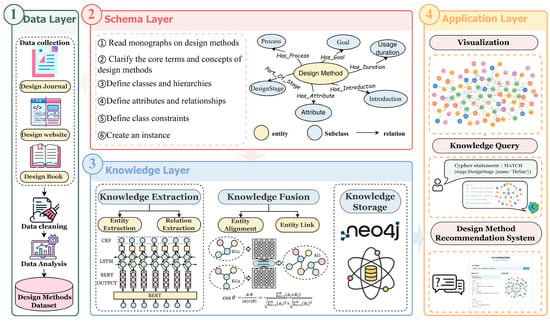
Figure 1.
A framework for constructing a design method knowledge graph driven by multi-source heterogeneous data.
3.1. Data Layer: Integration of Multi-Source Heterogeneous Datasets
The quality of the dataset is crucial for the effectiveness of the knowledge graph construction. The data for this study originates from our team’s prior work [25], which integrated 538 design methods across nine disciplines to construct a three-dimensional dataset based on theme, attribute, and stage. Although this dataset laid a foundation for the classification of design methods, it suffers from several limitations, such as incomplete data coverage, partial thematic mismatch, and inadequate knowledge descriptions. These issues hinder its direct application in supporting precise method matching and intelligent recommendation. To address these limitations, this study refines the dataset by proposing a technical pathway for integrating multi-source heterogeneous design method datasets. As illustrated in Figure 2, this pathway comprises four steps: extracting design themes from journals, extracting design methods from books, extracting design methods from websites, and establishing a multi-dimensional mapping between themes and methods.
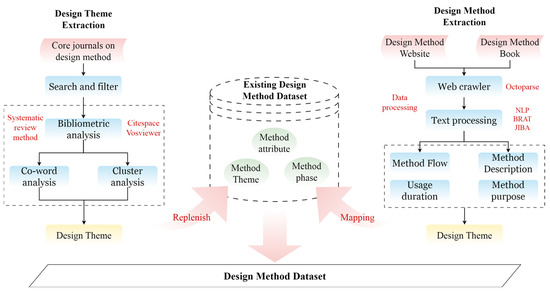
Figure 2.
Technical Pathway for Integrating Multisource Heterogeneous Design Method Datasets.
3.1.1. Design Themes Extraction from Journal Literature
The process for extracting design themes comprises the following three steps:
- Literature Retrieval and Screening: Using core design journals as the data source, a three-stage screening process (preliminary, secondary, and final) was conducted to select relevant articles.
- Bibliometric Analysis and Theme Identification: VOSviewer was employed to perform a bibliometric analysis of the literature. This analysis, combined with clustering, enabled the identification of key design themes.
- Theme Fusion and Dataset Iteration: The identified design themes were then integrated with the existing dataset to form a more comprehensive set of themes, providing essential data support for the subsequent construction of the knowledge graph.
3.1.2. Method Knowledge Extraction from Professional Books
After identifying the design theme, it is necessary to supplement the design method knowledge entity. Web crawler is a program that uses hyperlinks and document retrieval methods to continuously obtain various types of web page content from Internet pages [26]. Using design method publications as the data source, OCR tools are used to scan paper texts into PDFs, and then PyMuPDF in Python is used to extract the text, completing the digitization of the text.
3.1.3. Method Knowledge Extraction from Design Websites
To enhance the currency and diversity of our dataset, we extracted data from five prominent design method websites: “Design Method Toolkit”, “18F Methods”, “Design Methods Finder”, “Design Thinking Methoden Katalog”, and “Service Design Tools”. Using the web scraping tool Octopus, we collected key information for each method, including its description, objectives, and procedural steps. The data collection workflow is illustrated in Figure 3.

Figure 3.
Flowchart of Data Collection Using Octopus.
In this workflow, “elements” refers specifically to the data fields within the front-end HTML of a webpage that contains the target information. The element extraction process is performed through a visual configuration procedure. As illustrated in Figure 4, the operator uses mouse clicks within Octopus’s built-in browser to select the target content on the webpage intended for scraping, such as the “Purpose” and “Time required” fields highlighted in green. The text content corresponding to these selected fields is automatically extracted and populated into a table, forming an extraction template. Subsequently, the tool automatically applies this template to all similar pages; for example, it iterates through all listing pages via a “Loop ‘Click Next Page’“ command, thereby achieving automated, structured, and batch collection of the target information.
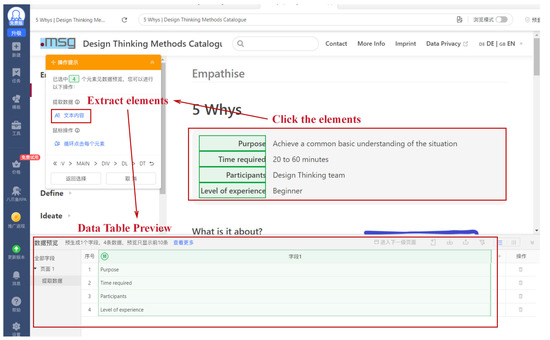
Figure 4.
Screenshot of Octopus Web Scraping Interface (Using “Design Thinking Methoden Katalog” Website as Example).
3.1.4. Mapping Design Themes to Methods
Establishing the mapping relationship between design themes and design methods is a core component of achieving knowledge association. This paper proposes a “Theme–Stage–Attribute” three-dimensional mapping model, as illustrated in Figure 5.
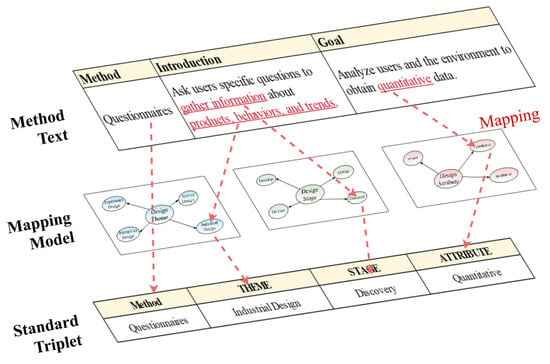
Figure 5.
The Design Theme: Method Mapping Model.
- Theme: The “Theme” dimension provides a top-level, discipline-oriented partition for the knowledge graph. This structure ensures that the knowledge graph is not merely a flat collection of methods, but a structured knowledge system that reflects the scope, theoretical frameworks, and practical concerns of different design disciplines. It offers a foundation for designers to navigate knowledge efficiently and define scope. Focusing on the field of design, this study identifies core design themes such as industrial design, user experience design, and service design, thereby constructing a domain-specific knowledge taxonomy.
- Stage: The stages are classified according to the “Double Diamond” model proposed by the UK Design Council [27], which includes Discover, Define, Develop, and Deliver. Dividing the design process into stages aims to decompose the complex cognitive activity of designing. Although numerous models describe design processes, the Double Diamond model is one of the most widely recognized in the field, providing a universal and highly inclusive reference framework for organizing design methods. However, due to the complexity of real-world design practice, some methods are applied across stages or used iteratively. Moreover, different teams may emphasize different aspects of the same method based on their specific focus and research objectives, leading to potential disagreements in classification. To maintain clarity in the graph structure, this paper assigns each method to the stage where it is primarily applied.
- Attribute: Based on knowledge representation logic, design methods are categorized into quantitative, qualitative, and mixed methods. This classification derives from the classic distinctions in social science research paradigms. Rech [28] argues that qualitative, quantitative, and mixed methods can be used within the same practical activity, but the choice of method should align with the research objectives. Incorporating the attribute dimension into the knowledge graph helps designers select and combine methods of different natures according to the overall emphasis of their design activity, thereby supporting more comprehensive insights.
Using this model, any design method can be precisely located within the three-dimensional coordinate system. For example, the “Questionnaire Survey method” can be mapped to the standard triplet “industrial design-discovery-quantitative method”. This lays the foundation for the precise retrieval and recommendation of design methods.
3.2. Schema Layer: Design Method Domain Ontology Construction
Ontologies are typically presented as concept sets and their hierarchical relationships, and are a prerequisite for knowledge graph construction. Based on Stanford University’s seven-step method [29], the ontology construction process is as follows:
- Determine the professional field and scope of the ontology: thoroughly read authoritative works, focus on various named entities, and record and organize the types and attributes of frequently occurring entities.
- Assess the feasibility of reusing existing ontologies: Conduct research and evaluation of existing publicly available ontology resources, analyze their structural characteristics, covered content, and scope of application, and assess the potential for reusing relevant ontologies.
- List important terms in the ontology: Identify the key terms required for ontology construction.
- Define classes and their hierarchical structure: Preliminary determination of the entity types and attribute characteristics of the knowledge graph.
- Define class attributes: Conduct an in-depth analysis of the characteristics and relationships of each entity type and systematically define class attributes.
- Define attribute facets: Divide attributes into subcategories and clarify the scope of application for each subcategory attribute.
- Create instances: Following the defined class, attribute, and attribute facet rules, use the Protégé tool to instantiate specific domain knowledge and refine the ontology model.
3.3. Knowledge Layer: Design Method Knowledge Graph Construction
3.3.1. Knowledge Extraction
Knowledge extraction consists of three steps: data annotation, entity recognition, and relationship extraction. Data annotation refers to labeling data in a format recognizable by the knowledge extraction model for training and testing purposes. The BIO (Begin, Inside, Outside) annotation method was adopted in this study. Named entity recognition was performed using the BERT-BiLSTM-CRF model to efficiently and accurately extract key entities such as design methods, tools, and processes. The structure is shown in Figure 6.
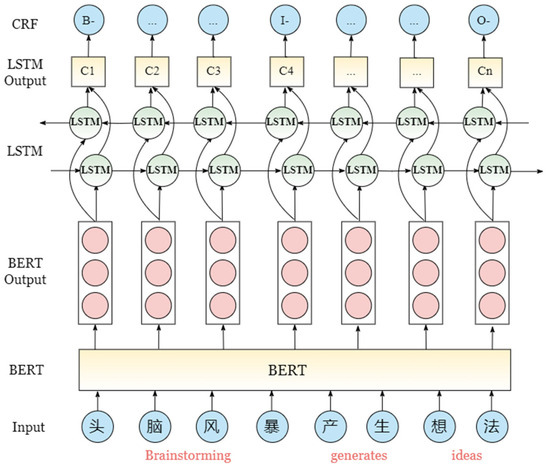
Figure 6.
BERT-BiLSTM-CRF model.
On this basis, combine regular expressions and syntactic analysis to further extract the relationships between entities.
The simplified pseudocode for the knowledge extraction process is shown in Algorithm 1.
| Algorithm 1: Design Knowledge Extraction |
| Require: C_raw: Raw corpus of design method texts. M_ner: A pre-trained BERT-BiLSTM-CRF model. Ensure: T_raw: A set of raw knowledge triples (head, relation, tail). 1: E_raw ← ∅, T_raw ← ∅ 2: for each text in C_raw do 3: // Entity Recognition 4: tagged_entities ← M_ner.predict(text) 5: E_raw ← E_raw ∪ tagged_entities 6: // Relation Extraction 7: relations ← ApplyRuleBasedMethods(text, tagged_entities) 8: T_raw ← T_raw ∪ BuildTriples(relations) 9: end for 10: return T_raw |
3.3.2. Knowledge Fusion
Design method data is mostly in English text, and the same design method entity may have multiple expressions after being translated into Chinese. Therefore, it is necessary to fuse together different expressions of the same method. This paper uses the Sentence-BERT model for similarity analysis, as shown in Figure 7.

Figure 7.
Sentence-BERT model.
Sentence-BERT (SBERT) constructs a BERT model to encode the two input sentences into semantic vectors. It then calculates the similarity between the vectors u and v of the two sentences using the cosine similarity formula, as shown below:
When the calculated similarity value exceeds the predefined threshold, it is determined that the group of semantic expressions belongs to the same entity category and can be fused.
3.3.3. Knowledge Storage
After obtaining structured triples, knowledge storage is required. Neo4j uses node–relationship–attribute triples to visualize knowledge networks and supports entity and relationship storage. The LOAD CSV statement is used to batch import preprocessed CSV (Comma-Separated Values) format triples into Neo4j to complete the visualization storage of knowledge networks.
4. Case Validation and Result Analysis
All experiments were conducted in a consistent environment. The hardware configuration for all experiments included a personal computer equipped with an Intel® Core™ i5-8300H CPU @ 2.30 GHz and 8 GB of RAM, running the Microsoft Windows 11 (64-bit) operating system. The software environment was based on Python 3.11. Key libraries and software used throughout the study include: Neo4j 5.26.0 for the graph database; VOSviewer 1.6.20 for bibliometric analysis; PyMuPDF 1.26.1 for PDF text extraction; Octopus 8.7.2 for web scraping; and Protégé 5.6.5 for ontology modeling.
During the model training phase, the pre-trained BERT version Bert-base-uncased was selected for the BERT-BiLSTM-CRF model. The hyperparameters were set as follows: 10 training epochs, a batch size of 16, and an LSTM hidden layer dimension of 256. To ensure stable fine-tuning, the AdamW optimizer was employed, with a learning rate of 2 × 10−5 for the BERT layer and 1 × 10−4 for the BiLSTM and CRF layers. In the knowledge fusion stage, the cosine similarity threshold for the Sentence-BERT model was set to 0.6.
4.1. Dataset and Ontology Construction
4.1.1. Dataset
The study first screened 694 design method-related articles from the journal Zhuangshi (https://www.izhsh.com.cn/ (accessed on 27 September 2025)) and employed keyword co-occurrence analysis to identify 10 core design themes. These include the following: discipline-centered themes such as Industrial Design, Visual Communication Design, and Fashion Design; human-centered themes such as User Experience Design, Interaction Design, Information Design, and Service Design; and humanity-centered themes such as Universal Design, Social Design, and Sustainable Design. These 10 themes constitute the “Theme” dimension in the “Theme–Stage–Attribute” mapping model, establishing a top-level classification framework for subsequent knowledge integration and association. Subsequently, 122 entries were extracted from books and 227 from web sources. After deduplication and integration, 203 design knowledge entries were obtained.
To ensure the depth and representativeness of the case study, this paper selects data from the “Industrial Design” theme, which has the broadest coverage, to form the source dataset for the knowledge graph, as shown in Table 1. Although the case study focuses on the single theme of “Industrial Design”, the framework proposed in this research is generalizable. The “Theme–Stage–Attribute” mapping model provides a scalable framework for organizing and associating knowledge and is independent of the semantic content of any specific theme. Therefore, the underlying design of the developed prototype system is capable of supporting all identified themes as well as the future addition of new ones.

Table 1.
Example of the Industrial Design Method Dataset.
4.1.2. Domain Ontology
Following the established procedure for domain ontology construction, we modeled the design method knowledge, with the resulting ontology illustrated in Figure 8.
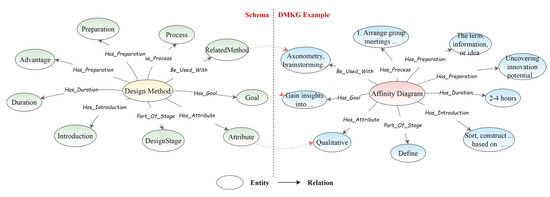
Figure 8.
Ontology model.
Based on the model in Figure 8, we defined the entity types and relation types, which are detailed in Table 2 and Table 3, respectively. In total, the ontology comprises 10 entity types and 10 relation types.

Table 2.
Entity Types.

Table 3.
Relation Types.
4.2. Knowledge Extraction and Fusion
4.2.1. Knowledge Extraction
Based on defined entity and relationship types, BIO annotation rules were used to annotate the design method data text. After data aggregation, deduplication, fusion, and organization, the extraction results were presented as nodes and relationship triples. A total of 560 entities (nodes) and 946 relationships (edges) were obtained from this knowledge extraction and placed in two UTF-8 format CSV files, as shown in Figure 9.
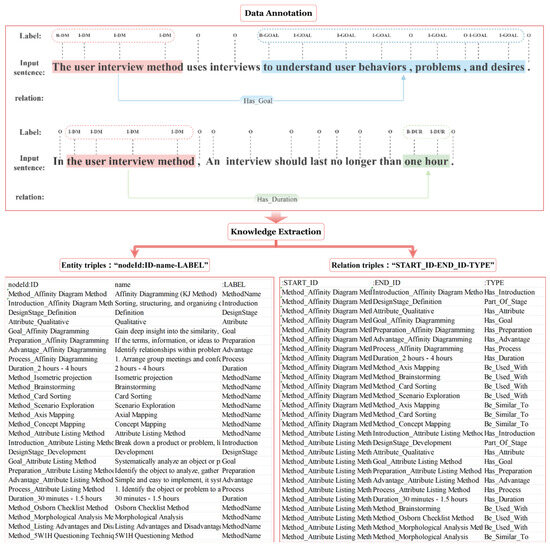
Figure 9.
Knowledge extraction process.
4.2.2. Knowledge Fusion
Using the Sentence-BERT model, 20 pairs of similar entities were randomly selected for manual verification. The results showed that the entity alignment accuracy rate was 92.3%, indicating that the fusion algorithm can effectively eliminate redundant expressions. For example, the semantic similarity between “user interview method” and “in-depth user interview” was 0.83, and after manual confirmation, they were merged into a single entity.
4.2.3. Extraction Performance Verification
To validate the knowledge extraction performance of the proposed model, traditional CRF models and BiLSTM+CRF models were selected as benchmarks for comparison experiments. The corpus was constructed based on the industrial design method dataset described in Section 4.1.1, and was randomly divided into 80% for training, 10% for validation, and 10% for testing. The extraction performance was evaluated using the metrics of precision, recall, and F1 score [15]. The experimental results are shown in Figure 10.
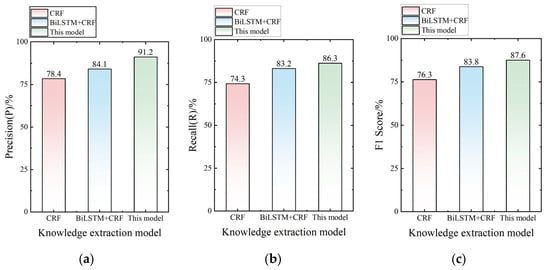
Figure 10.
Knowledge extraction performance test results: (a) Precision; (b) Recall; (c) F1 score.
The results show that the BiLSTM+CRF model outperforms the CRF model in terms of accuracy, recall, and F1 score. The BERT-BiLSTM-CRF model maintains the highest scores across all three classification metrics, particularly achieving an accuracy of 91.2%, which has an 8.44% improvement over the BiLSTM+CRF model. This validates the superior performance of the models employed in this study.
4.3. Knowledge Storage and Application
4.3.1. Knowledge Storage
Import the CSV triplet file obtained after knowledge extraction and fusion into the Neo4j graph database for storage.
4.3.2. Graph Quality Validation
To ensure the accuracy, completeness, and practicality of the constructed design method knowledge graph, experimental validation was conducted from two dimensions: content completeness and functional effectiveness. The process and results are described below.
- Content Completeness Validation
Knowledge coverage is a key metric for evaluating the knowledge collection and relationship construction capabilities of a knowledge graph, including node coverage and relationship coverage. Node coverage measures the proportion of actual key nodes included in the total number of expected nodes; relationship coverage measures the proportion of actual relationships between nodes in the total number of expected relationships. The knowledge coverage of the graph was calculated in Neo4j using Cypher statements, as shown in Algorithm 2.
| Algorithm 2: Cypher statements for calculating knowledge coverage |
| MATCH (n: Design Method) WITH count(n) AS design methods count MATCH (n1: Design Method)-[r]-(n2: Design Method) WITH design_methods_count, count(r) As design_method_relationships_count WITH design_methods_count, design_method_relationships_count, Expected design_methods_count, Expected design_method_relationships_count RETURN |
The calculation results are shown in Table 4.

Table 4.
Knowledge Graph Quality Validation Results.
The results show that the node coverage of this knowledge map is 94.1%, approaching 1, which validates the completeness of the knowledge map in terms of knowledge element collection and supports node-based knowledge retrieval, classification, and other applications. The relationship coverage is 91.2%, which can support a certain degree of association analysis and is feasible.
- 2.
- Functional Effectiveness Validation
This section aims to compare the knowledge query effectiveness of the Design Method Knowledge Graph (DMKG) constructed in this paper with a traditional Tag-based Knowledge Retrieval System (TKRS) framework. The comparison is designed to validate the advantages of the proposed framework in processing complex semantic queries. The experimental design is as follows:
Baseline Model: To ensure a fair comparison, external online platforms with uncontrollable functionalities and datasets were not used as the baseline model. Instead, a tag-based knowledge retrieval model was implemented using the same dataset as our knowledge graph, referencing the tag classification method of the “Design Methods Finder”. This approach ensured that the sole variable between the two frameworks was their underlying logic for knowledge organization and reasoning.
Test Query Set: The test set comprises a total of 30 queries, which are divided into three categories to evaluate different levels of query depth. Each category contains 10 queries, as detailed in Table 5 below:

Table 5.
Knowledge Graph Quality Validation Results.
Evaluation Metrics: The evaluation employs Success Rate, Precision, Recall, and F1-Score as the evaluation metrics. In these calculations, TP represents the number of correct answers returned by the model, FP represents the number of incorrect answers returned, and FN represents the number of correct answers that the model failed to return.
The core algorithm for this comparative query experiment is presented in Algorithm 3.
| Algorithm 3: Comparative Query Effectiveness Evaluation |
| Require: Q: A set of test queries, where each q contains {Query_ID, Category, DMKG_Query, TKRS_Tags, Ground_Truth}. D_tkrs: The baseline dataset in JSON format. G_dmkg: The Neo4j graph database instance. Ensure: M: A summary table of performance metrics (Precision, Recall, F1-Score) for each system and category. 1: R ← ∅ (Initialize an empty collection for results) 2: for each q in Q do 3: gt ← q.Ground_Truth (Extract the ground truth answers) 4: // Evaluate Baseline System (TKRS) 5: tkrs_tags ← q.TKRS_Tags 6: results_tkrs ← QueryTKRS(tkrs_tags, D_tkrs) 7: metrics_tkrs ← CalculateMetrics(results_tkrs, gt) 8: R ← R ∪ {(“TKRS”, q.Category, metrics_tkrs)} (Store the result) 9: // Evaluate Knowledge Graph (DMKG) 10: dmkg_cypher ← q.DMKG_Query 11: results_dmkg ← QueryDMKG(dmkg_cypher, G_dmkg) 12: metrics_dmkg ← CalculateMetrics(results_dmkg, gt) 13: R ← R ∪ {(“DMKG”, q.Category, metrics_dmkg)} (Store the result) 14: end for 15: M ← AggregateResultsByCategory(R) 16: return M |
The test results are shown in Table 6.

Table 6.
Knowledge Query Test Results. (‘-’ means the metric is Not Applicable.).
The results indicate that in the C1 multi-dimensional filtering queries, the FCS performs well as a strong baseline, achieving an F1 score of 0.91. The DMKG demonstrates superior performance, reaching an F1 score of 0.96. However, the performance gap becomes significant when the query tasks require semantic understanding. In the C2 and C3 queries, the FCS fails completely due to its inability to comprehend the relationships between tags. In contrast, the DMKG, by leveraging the explicit relationships within its graph structure, maintains exceptionally high performance, achieving F1 scores of 0.97 and 0.90, respectively.
This performance disparity stems from the fundamental difference in knowledge representation between the two frameworks. The performance of the FCS is constrained by its flat tag system, which can only process queries based on exact tag matching. Its retrieval logic fails when encountering queries that require an understanding of semantic relationships. Conversely, the superiority of the DMKG is due to its rich semantic network structure. By modeling knowledge elements such as design methods, stages, and attributes as entities connected by defined relationships, it can deeply understand and execute complex semantic queries.
Overall, the knowledge graph demonstrates a high level of knowledge inclusion and relationship construction, providing a reliable foundation for subsequent academic research and practical applications.
4.3.3. Knowledge Graph Applications
- Knowledge Visualization and Query
In Neo4j, the entire knowledge network can be intuitively presented, as shown in Figure 11. Designers can use Cypher query statements to quickly filter and locate suitable design methods based on specific requirements such as “industrial design”, “definition phase”, and “qualitative methods”. The query results not only display the names of the methods but also include detailed information such as their descriptions, objectives, and steps to assist designers in making decisions.
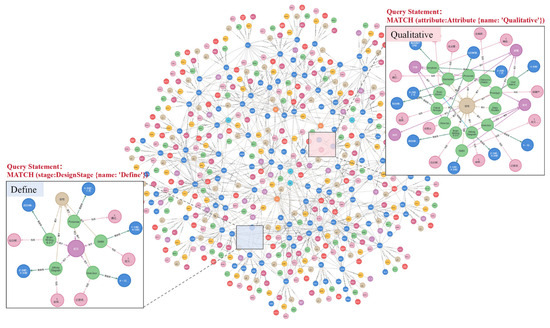
Figure 11.
Knowledge visualization, query definition stage, and qualitative dimension design method results example diagram.
- 2.
- Design Method Recommendation Prototype System
To validate the effectiveness and practicality of the design method knowledge graph constructed in this paper in actual applications, a design method recommendation system prototype was developed, as shown in Figure 12. The system aims to intelligently match design methods based on the designer’s design requirements. The specific interaction process is as follows:
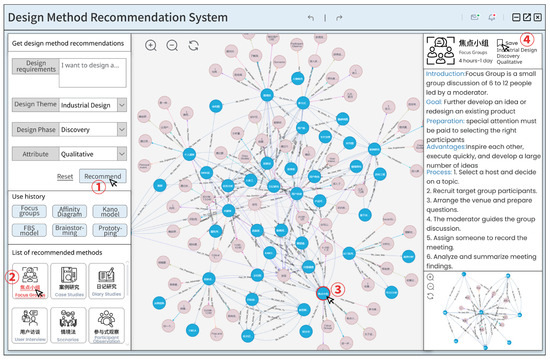
Figure 12.
Design Method Recommendation System Prototype Interface.
- Requirement input and method matching: Users specify their specific design requirements by selecting specific “design theme”, “design stage”, and “method attribute” in the system’s interactive interface. After clicking the “Recommend” button, the system performs reasoning based on the knowledge graph to filter out eligible candidate design methods.
- Recommendation Result Presentation: The system displays the matched methods in the “Recommended Method List” on the left side, providing users with a clear and intuitive overview of the options.
- Knowledge Association Exploration: Users can click on any method node of interest in the visualized graph or select from the recommended list. The system will then display detailed information about the selected method in the knowledge cards on the right side of the interface, including its definition, objectives, process, advantages, etc., to assist users in conducting in-depth exploration and comparison.
- Method Information Export: After reviewing specific methods, users can use the “Save” function to export the required method knowledge for subsequent record-keeping and application.
The successful development of this prototype system will effectively assist designers in retrieving and using design methods, validating the value of knowledge graphs in practical work.
5. Conclusions
To address the fragmentation and inefficient retrieval of design method knowledge, this paper proposes and validates a framework for constructing a knowledge graph driven by multi-source heterogeneous data. Its core value lies not only in integrating scattered design knowledge but also in exploring a feasible pathway to transform static, isolated text into a dynamic, interconnected knowledge network. Experimental results confirm that the framework effectively integrates fragmented knowledge and significantly outperforms traditional knowledge organization paradigms in supporting complex semantic queries. This demonstrates that the proposed graph is not merely a repository of information, but a reasoning engine capable of heuristic querying, providing designers with knowledge exploration functions that go beyond traditional keyword-based retrieval.
However, this study has certain limitations. First, the current graph construction primarily relies on textual data processing and does not adequately incorporate multimodal knowledge such as diagrams and videos. Second, to ensure structural clarity, the “primary application scenario” criterion adopted in this study leads to an inevitable simplification of core attributes and loss of secondary information. While this approach establishes a foundational knowledge network, it fails to finely model the multiple application patterns and iterative characteristics of a single method across different stages. Finally, although the framework is designed to be extensible, the case validation primarily focuses on the core theme of “Industrial Design”. Its dynamic adaptability within the continuously evolving global design knowledge ecosystem requires further examination.
Therefore, future research will focus on three directions for further development: first, multimodal knowledge fusion, exploring the integration of technologies such as visual language models with the existing framework to enable semantic extraction of non-textual knowledge; second, contextual knowledge modeling, investigating how to more precisely represent the cross-stage application and iterative relationships of methods, enabling the knowledge graph to better reflect the complexity of real-world design practice; third, dynamic evolution and intelligent reasoning, researching incremental automatic knowledge update mechanisms and deeper integration with Large Language Models (LLMs), thereby advancing the intelligence level of design knowledge management to new heights.
Author Contributions
Conceptualization, J.S. and K.W.; methodology, J.S., K.W. and Z.W.; software, K.W.; validation, K.W.; formal analysis, J.S. and K.W.; investigation, J.S., K.W. and Z.W.; resources, J.S. and F.H.; data curation, K.W.; writing—original draft preparation, K.W.; writing—review and editing, J.S., Z.B. and F.H.; visualization, K.W.; supervision, J.S., Z.B. and F.H.; project administration, J.S., Z.B. and F.H.; funding acquisition, J.S. All authors have read and agreed to the published version of the manuscript.
Funding
This research was funded by the Hebei Province Philosophy and Social Science Foundation of China Grant No. HB23YS037.
Institutional Review Board Statement
Not applicable.
Informed Consent Statement
Not applicable.
Data Availability Statement
Data are contained within the article.
Conflicts of Interest
The authors declare no conflicts of interest.
References
- Cash, P.; Daalhuizen, J.; Hekkert, P. Evaluating the Efficacy and Effectiveness of Design Methods: A Systematic Review and Assessment Framework. Des. Stud. 2023, 88, 101204. [Google Scholar] [CrossRef]
- Liu, Y.; Li, X.; Yu, D.; Xu, Y. Medical Information Management System Based on Multi-Source Heterogeneous Big Data. Comput. Methods Biomech. Biomed. Eng. Imaging Vis. 2024, 12, 2389816. [Google Scholar] [CrossRef]
- Liu, X.; Werder, K.; Maedche, A.; Sun, L. Situational Selections of Design Methods for Digital Innovation Processes. Int. J. Inf. Secur. 2025, 17, 373–393. [Google Scholar] [CrossRef]
- Gerrike, K.; Eckert, C.; Stacey, M. What Do We Need to Say about a Design Method? In Proceedings of the 21st International Conference on Engineering Design, ICED17, Vancouver, QC, Canada, 21–25 August 2017. [Google Scholar]
- Sanhueza, K.S.; Nikulin, C. A Framework for Design Methods, Models and Techniques for Product and Process Development: A Novel Classification to Increase Their Applicability in Practices. Bus. Process Manag. J. 2019, 25, 1759–1782. [Google Scholar] [CrossRef]
- Roy, R.; Warren, J.P. Card-Based Design Tools: A Review and Analysis of 155 Card Decks for Designers and Designing. Des. Stud. 2019, 63, 125–154. [Google Scholar] [CrossRef]
- Ji, S.; Pan, S.; Cambria, E.; Marttinen, P.; Yu, P.S. A Survey on Knowledge Graphs: Representation, Acquisition, and Applications. IEEE Trans. Neural Netw. Learn. Syst. 2022, 33, 494–514. [Google Scholar] [CrossRef]
- Štorga, M.; Andreasen, M.M.; Marjanović, D. The Design Ontology: Foundation for the Design Knowledge Exchange and Management. J. Eng. Des. 2010, 21, 427–454. [Google Scholar] [CrossRef]
- Moon, S.K.; Simpson, T.W.; Kumara, S.R.T. A Methodology for Knowledge Discovery to Support Product Family Design. Ann. Oper. Res. 2010, 174, 201–218. [Google Scholar] [CrossRef]
- Bohm, M.R.; Stone, R.B.; Szykman, S. Enhancing Virtual Product Representations for Advanced Design Repository Systems. J. Comput. Inf. Sci. Eng. 2005, 5, 360–372. [Google Scholar] [CrossRef][Green Version]
- Jiang, S.; Yang, J.; Xie, J.; Xu, X.; Dou, Y.; Jing, L. Product Innovation Design Approach Driven by Implicit Relationship Completion via Patent Knowledge Graph. Adv. Eng. Inform. 2024, 61, 102530. [Google Scholar] [CrossRef]
- Sun, Y.; Liu, W.; Cao, G.; Peng, Q.; Gu, J.; Fu, J. Effective Design Knowledge Abstraction from Chinese Patents Based on a Meta-Model of the Patent Design Knowledge Graph. Comput. Ind. 2022, 142, 103749. [Google Scholar] [CrossRef]
- Chen, L.; Cai, Z.; Jiang, Z.; Sun, L.; Childs, P.; Zuo, H. A Knowledge Graph-Based Bio-Inspired Design Approach for Knowledge Retrieval and Reasoning. J. Eng. Des. 2024, 36, 1321–1351. [Google Scholar] [CrossRef]
- Huang, Y.; Yu, S.; Chu, J.; Su, Z.; Zhu, Y.; Wang, H.; Wang, M.; Fan, H. Design Knowledge Graph-Aided Conceptual Product Design Approach Based on Joint Entity and Relation Extraction. J. Intell. Fuzzy Syst. 2023, 44, 5333–5355. [Google Scholar] [CrossRef]
- Liu, P.; Qian, L.; Zhao, X.; Tao, B. The Construction of Knowledge Graphs in the Aviation Assembly Domain Based on a Joint Knowledge Extraction Model. IEEE Access 2023, 11, 26483–26495. [Google Scholar] [CrossRef]
- Bharadwaj, A.G.; Starly, B. Knowledge Graph Construction for Product Designs from Large CAD Model Repositories. Adv. Eng. Inform. 2022, 53, 101680. [Google Scholar] [CrossRef]
- Qiao, B.; Zou, Z.; Huang, Y.; Fang, K.; Zhu, X.; Chen, Y. A Joint Model for Entity and Relation Extraction Based on BERT. Neural Comput. Appl. 2022, 34, 3471–3481. [Google Scholar] [CrossRef]
- Nie, Y.; Huang, N.; Peng, J.; Song, G.; Zhang, Y.; Peng, Y.; Ni, C. Research on the Construction and Application of Knowledge Graph in the Ceramic Field Based on Natural Language Processing. Int. J. Semantic Web Inf. Syst. 2023, 19, 1–20. [Google Scholar] [CrossRef]
- Wu, W.; Wen, C.; Yuan, Q.; Chen, Q.; Cao, Y. Construction and Application of Knowledge Graph for Construction Accidents Based on Deep Learning. Eng. Constr. Archit. Manag. 2023, 32, 1097–1121. [Google Scholar] [CrossRef]
- Trisedya, B.D.; Qi, J.; Zhang, R. Entity Alignment between Knowledge Graphs Using Attribute Embeddings. In Proceedings of the AAAI Conference on Artificial Intelligence 2019, Honolulu, HI, USA, 27 January–1 February 2019; Volume 33, pp. 297–304. [Google Scholar] [CrossRef]
- Cheng, Y.; Li, Y.; Zhang, N.; Chen, L.; Cao, J. A Knowledge Graph-Enabled Multi-Domain Mapping Approach Supporting Product Rapid Design: A Case Study of New Energy Vehicles. Adv. Eng. Inform. 2024, 62, 102779. [Google Scholar] [CrossRef]
- Eremeev, A.P.; Muntyan, E.R. Developing an Ontology on the Basis of Graphs with Multiple and Heterotypic Connections. Sci. Tech. Inf. Proc. 2022, 49, 427–438. [Google Scholar] [CrossRef]
- Aldughayfiq, B.; Ashfaq, F.; Jhanjhi, N.Z.; Humayun, M. Capturing Semantic Relationships in Electronic Health Records Using Knowledge Graphs: An Implementation Using MIMIC III Dataset and GraphDB. Healthcare 2023, 11, 1762. [Google Scholar] [CrossRef]
- Saad, M.; Zhang, Y.; Tian, J.; Jia, J. A Graph Database for Life Cycle Inventory Using Neo4j. J. Clean. Prod. 2023, 393, 136344. [Google Scholar] [CrossRef]
- Hu, F.; Mi, J. Research on domain method and general method of design. J. Nanjing Arts Inst. (Fine Arts Des.) 2022, 2022, 70–77. (In Chinese) [Google Scholar]
- Hernandez, J.; Marin-Castro, H.M.; Morales-Sandoval, M. A Semantic Focused Web Crawler Based on a Knowledge Representation Schema. Appl. Sci. 2020, 10, 3837. [Google Scholar] [CrossRef]
- The Design Council. The Double Diamond [EB]. Available online: https://www.designcouncil.org.uk/our-resources/the-double-diamond/ (accessed on 27 September 2025).
- Rech, S.R. Trends management: The qualitative approach as a methodology. In Perspective on Design: Research, Education and Practice; Springer International Publishing: Cham, Switzerland, 2019; pp. 283–292. [Google Scholar]
- Liu, D.; Cheng, L. MAKG: A Maritime Accident Knowledge Graph for Intelligent Accident Analysis and management. Ocean Eng. 2024, 312, 119280. [Google Scholar] [CrossRef]
Disclaimer/Publisher’s Note: The statements, opinions and data contained in all publications are solely those of the individual author(s) and contributor(s) and not of MDPI and/or the editor(s). MDPI and/or the editor(s) disclaim responsibility for any injury to people or property resulting from any ideas, methods, instructions or products referred to in the content. |
© 2025 by the authors. Licensee MDPI, Basel, Switzerland. This article is an open access article distributed under the terms and conditions of the Creative Commons Attribution (CC BY) license (https://creativecommons.org/licenses/by/4.0/).









